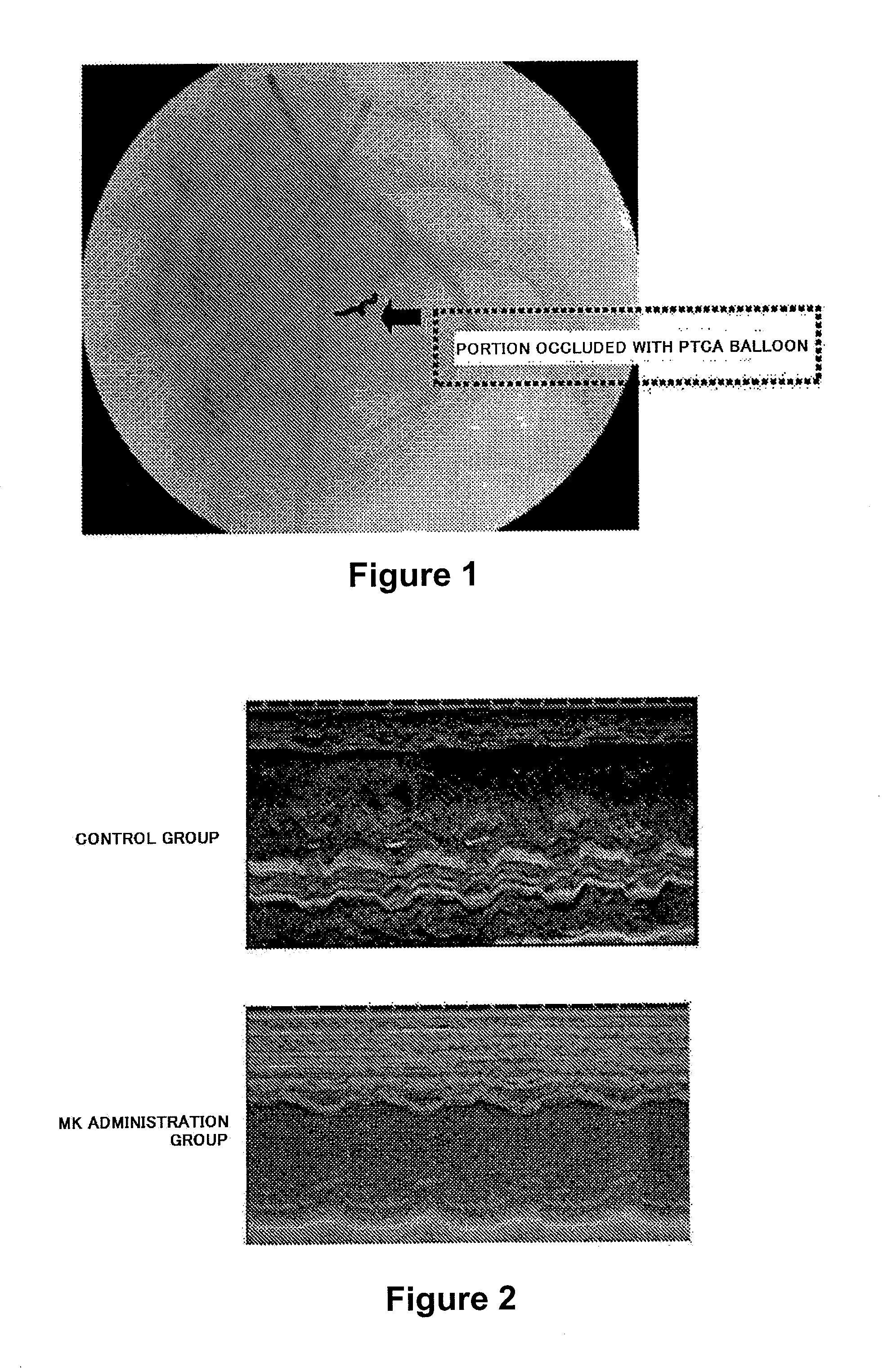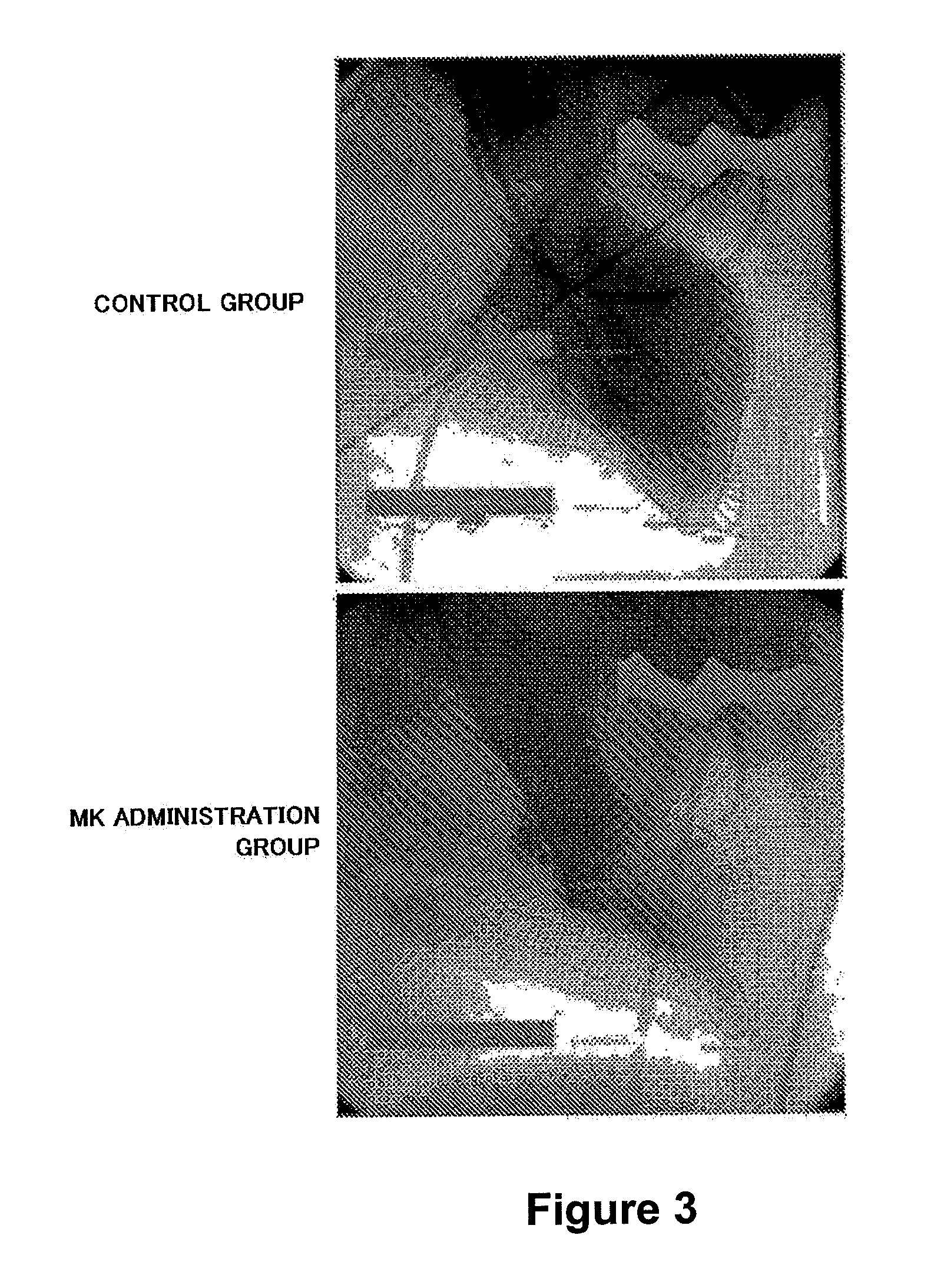Activation of endothelial nitric oxide synthase by midkine and uses therefor in effecting vasodilation
a technology of nitric oxide synthase and activator, which is applied in the direction of drug composition, peptide/protein ingredient, metabolic disorder, etc., can solve the problems of myocardial infarction, cell dysfunction, muscle angina, etc., and achieve the effect of fewer side effects and treatment or prophylaxis of diseases and symptoms
- Summary
- Abstract
- Description
- Claims
- Application Information
AI Technical Summary
Benefits of technology
Problems solved by technology
Method used
Image
Examples
example 1
Therapeutic Effect of Intracoronary Administration of MK on Myocardial Cell Dysfunction After Ischemia-Reperfusion (Administration Throughout Occlusion)
(1) Preparation of MK
[0092]Human MK mRNA was prepared from Wilms' tumor-derived cultured cell strain G-401 (Tsutui, J. et al., Biochem. Biophys. Res. Commun. 176, 792-797, 1991). 30 cycles of PCR were carried out to prepare a human MK cDNA having an EcoRI recognition site at both ends of an MK coding region. One cycle of the PCR consists of a temperature change of 93° C.→37° C.→72° C. A sense PCR primer (5′-GCGGAATTCATGCAGCACCGAGGCTTCCTC-3′) and an antisense PCR primer (5′-GCGGAATTCCTAGTCCTTTCCCTTCCCTTT-3′) which were designed so as to contain a sequence (5′-GAATTC-3′) recognized by a restriction enzyme EcoRI were used as primers. The human MK mRNA was used as a template.
[0093]The MK cDNA expression vector pHIL301 (histidine and neomycin resistance genes-containing expression vector; see JP-A 2-104292 and EP Patent Publication No. 03...
example 2
Therapeutic Effect of Intracoronary Administration of MK on Myocardial Cell Dysfunction After Ischemia-Reperfusion (Administration After Occlusion)
(1) Preparation of MK, Creation of an Ischemic Model Animal, and Administration of MK
[0110]Human MK was prepared in the same manner as described in Example 1. The same experiment as described in Example 1 was carried out except that a model animal was administered continuously with 5 μg / kg MK or physiological saline 5 to 10 minutes after cancellation of occlusion.
(2) Results
[0111]It was revealed that no significant difference was recognized in the cases where administration was initiated during occlusion and in the cases where administration was initiated after relief of occlusion from both of the results of the MK administration group and the physiological saline administration group. This result indicated that administration after relief of occlusion also achieves the therapeutic effect of MK on cell dysfunction (not shown).
example 3
Detection of an Accumulated Site of MK by Intracoronary Administration
(1) Preparation and Administration of Fluorescence-Labeled MK
[0112]Human MK was prepared in the same manner as described in Example 1. A fluorescent dye rhodamine was bound to the prepared MK to give fluorescence-labeled MK. The florescence-labeled MK was administered to a pork pig (male, about 40 kg) in the same manner as described in Example 1. 24 hours after administration, the heart was removed and myocardial tissue was observed under a fluorescence microscope to detect accumulation of the fluorescence-labeled MK.
(2) Results
[0113]The results are shown in FIGS. 14 and 15. As shown in FIG. 14, the fluorescence-labeled MK was accumulated in the damaged myocardial site of the porcine heart, while as shown in FIG. 15, the fluorescence-labeled MK was not accumulated in a normal site of the porcine heart. From this result, it was revealed that MK administered via an coronary artery at the time of heart damage was acc...
PUM
| Property | Measurement | Unit |
|---|---|---|
| temperature | aaaaa | aaaaa |
| concentration | aaaaa | aaaaa |
| ischemia disorder | aaaaa | aaaaa |
Abstract
Description
Claims
Application Information
 Login to View More
Login to View More - R&D
- Intellectual Property
- Life Sciences
- Materials
- Tech Scout
- Unparalleled Data Quality
- Higher Quality Content
- 60% Fewer Hallucinations
Browse by: Latest US Patents, China's latest patents, Technical Efficacy Thesaurus, Application Domain, Technology Topic, Popular Technical Reports.
© 2025 PatSnap. All rights reserved.Legal|Privacy policy|Modern Slavery Act Transparency Statement|Sitemap|About US| Contact US: help@patsnap.com



